|
1850. Jonathan Harker (Bruno Ganz) is an estate agent sent to Transylvania to visit Count Dracula (Klaus Kinski), who wants to buy a property in Germany. Jonathan leaves his wife Lucy (Isabelle Adjani) behind. Stopping on his way at an inn, Jonathan is warned by locals not to proceed to Dracula's castle, but he ignores them…
Nosferatu the Vampyre (Nosferatu Phantom der Nacht) was Werner Herzog's eighth fiction feature, which arrived with some anticipation in 1979 as it was his first genre film and his first remake. Rather out of step with what was going on in horror at the time, and ultimately more successful with arthouse audiences than genre ones, Herzog's Nosferatu remains a striking work, not least for being episode two of an eventual five of his frequently fraught collaboration with Klaus Kinski.
Murnau's film was an unauthorised version of Bram Stoker's 1897 novel Dracula, with the serial numbers filed off (for example, the undead one is renamed Count Orlok) in an unsuccessful attempt to distract attention from that fact. Murnau had form in horror and the macabre, though as earlier examples are now lost films, it's easy not to be aware of that. But his filmography included a take on Dr Jekyll and Mr Hyde, Der Januskopf (1920), starring Conrad Veidt with Bela Lugosi in a supporting role, and photographed by Karl Freund. With their participation as well as Murnau's you can see why it's a particularly sought-after lost film. Nosferatu featured Max Schreck as Orlok, and his sheer presence, under heavy make-up, long-fingered, stooped and almost insectoid, is indelible. People often forget that Schreck was a working actor who made forty-eight films between 1920 and 1936 – he died that year, aged fifty-six, of a heart attack – including another for Murnau (The Grand Duke's Finances (Die Finanzen des Großherzogs), 1924). The 2000 film Shadow of the Vampire is a fictional account of the film's making, with the conceit that Schreck was an actual vampire.
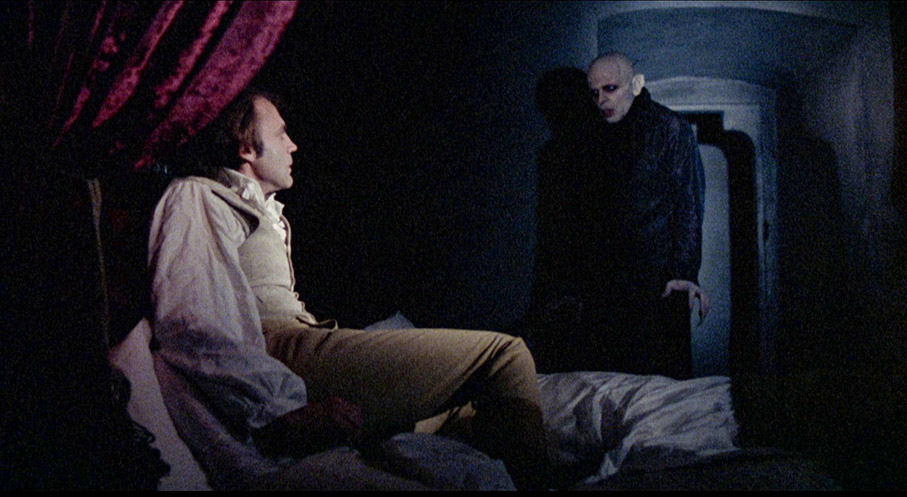
Nosferatu was released in Germany in March 1922 and was immediately hit with a successful lawsuit for copyright infringement by Florence Stoker, the author's widow. An attempt to release the film in the UK was stymied when the British Board of Film Censors (as was) rejected it in December of that year. In the absence of surviving records, it's unclear whether the BBFC thought the film was too horrific to pass or if they were aware of the lawsuit and anticipated that a British court would find against the film much as their German equivalent had. Mrs Stoker not only tried to have the film banned but also destroyed, but fortunately failed in the latter. Murnau's film had its British premiere in 1928 in London due to The Film Society, who, being a club charging membership, could show films which hadn't been passed by the BBFC. That was the last showing of Nosferatu in the UK until well after the Second World War and it was finally passed by the Board, uncut with an A certificate, in 1973.
By 1979, Stoker's novel had passed out of copyright so Herzog (writing the screenplay) reverted the character names to the originals, even though he retained Murnau's title. 20th Century Fox released the film in the USA and UK and likely thought the film much more of a commercial prospect than Herzog's previous films, not just for its genre but also for name recognition. That's a reason for the film being shot in two versions, German and English. Unlike Aguirre, The Wrath of God, which was shot once and postdubbed into both German and English, the dialogue scenes were shot in separate takes for each version, with the cast clearly delivering their lines in the appropriate language. German was the native language of the German Klaus Kinski and the Swiss Bruno Ganz, though both they and Isabelle Adjani had worked in English-language films before. Adjani and Roland Topor (playing Renfield) were both French, so their voices were replaced at least in the German version, as was the case with some minor roles played by Dutch actors. Another reason for the two versions was practicality: as the cast and crew covered several nationalities and native languages, with shooting in the then Czechoslovakia and the Netherlands as well as in West Germany, English was something of a lingua franca during the production. (As Ceaușescu's regime was in power in Romania, shooting in the actual Transylvania was impossible.) Both versions are available on this disc, so the choice is yours. For the record, Herzog thought the German version was "the most authentic" one.
While Nosferatu is a horror film, it was at some remove from what was happening in the genre at the time. The measured pace disconcerted Fox, who found the film slow. What might have been highlights in another film were played down. Herzog conveys Jonathan and Lucy's closeness in the early stages by having them walk away from the camera together in long shot, instead of close-up kisses and embraces. Finally, what would have been the climax of many another vampire film happens offscreen. There is in fact very little blood onscreen.
As with many Herzog films before and since, including ones shot in more exotic locales than this, landscape is important, with the characters being figures in it. That comes to the fore as Harker rides to Dracula's castle, Jörg Schmidt-Reitwein's camera taking in the fields and mountains of what is now Slovakia. The mood, and stylisation, feeds into the performances. Kinski's often manic energy is tamped right down, and there's a melancholy and sensitivity about Dracula's undead existence, visible under makeup which took four hours to apply each day. He was also given three-inch lifts in his shoes so that he noticeably towers over the other cast. (Kinski was 5'8", already two inches taller than Ganz, though rather shorter than Max Schreck, who was 6'3".) Isabelle Adjani seems to be channelling many a silent-film heroine, often gesticulating and at one point fainting. Often dressed in white, Lucy is the film's symbol of virginal purity (though, as a married woman, she's presumably no longer one) which allows her to combat Dracula in the film's later stages. Adjani and Herzog have not worked together again, though he and Kinski did three more times: Woyzeck in the same year, Fitzcarraldo (1982) and Cobra Verde (1987). Kinski died in 1991.
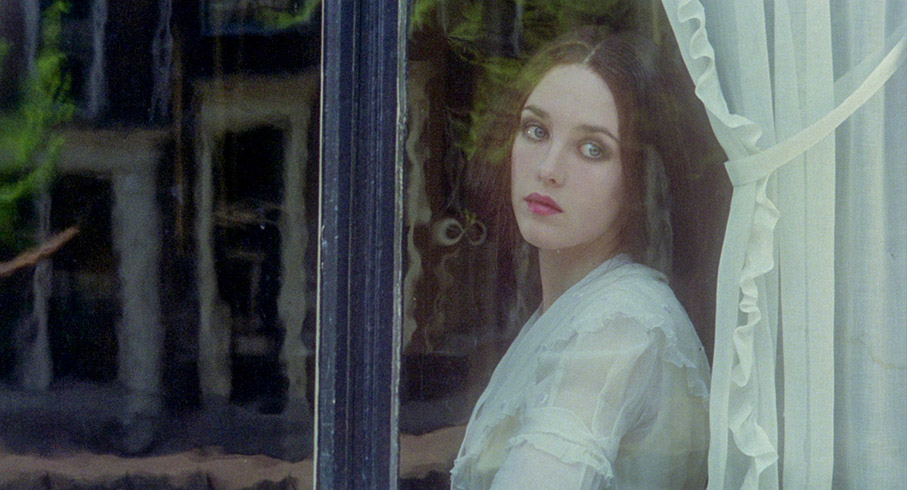
Nosferatu had some success in its coproduction nations of West Germany and France, but much less so in the USA. In the UK it was released in both language versions, but most likely played in German as it had a largely arthouse release. Yet, from Herzog's great period – which for his fiction features I'd suggest ran from Aguirre to Fitzcarraldo, a span of a decade – it has endured, and now joins Aguirre as a UHD release from the BFI.
Nosferatu the Vampyre is released by the BFI in UHD and Blu-ray, the latter disc encoded for Region B only. The film was previously released in 2014 as part of the eight-disc, eighteen-film Werner Herzog Collection box set, which is still available in its Blu-ray and DVD iterations, and the extras from that release are carried forward to this new one. Nosferatu had a AA certificate (restricted to over-fourteens) on its original cinema release, but in 2013 was rerated to 12A for a cinema reissue. For home viewing, the film has a 15 certificate and as it in either version has not been resubmitted to the BBFC, that certificate stands. Nosferatu is presented on this disc in both its German and English versions, respectively running 106:42 and 107:00. Depending on which version you choose, the opening credits will be in the appropriate language. (There are no end credits, only nearly a minute of black screen with Popul Vuh's choral music on the soundtrack.)
Herzog's first four features were in 1.37:1 and the next three in 1.66:1. For Nosferatu, shot in 35mm colour, he went a little wider, 1.85:1, possibly due to the possibility it might play in US cinemas where that was the standard projection ratio. Over to Slarek for comments on the picture and sound.
The accompanying booklet reveals that the 2160p transfer on this BFI UHD was sourced from a 4K scan of the film's 35mm negative, and remastered in high dynamic range with Dolby Vision by Alpha-Omega Digital GmbH in Germany, the same company responsible for the restoration on the BFI UHD of Aguirre, the Wrath of God. I mention this primarily because, as with that transfer, there are a small number of shots here where surfaces of objects feel almost unnaturally smooth, as if a small amount of Digital Noise Reduction had been applied. Despite my suspicions, I ultimately leaned against this in my Aguirre coverage, but given that both remasters were carried out by the same firm with similar results, I'm not so sure. I could be completely wrong on this, and fortunately the effect is minor and confined to a small sprinkling of shots (the feast of food laid out for Harker, the wide shot of the boatmen steering a raft of coffins down a river). For the most part, the transfer is a strong one, with a wonderfully rich and organically filmic look, nicely graded contrast, decent shadow detail, the deepest of black levels when required, and no burn-outs on the all-important whites. The colour palette is subdued, having a pastel leaning with greens, browns and greys often dominating, but this is by design and is most pleasingly presented, and on the rare occasions where brighter colours do appear, they are vibrantly presented. One unexpected side-effect of such a crisp transfer is that it does highlight a small sprinkling of shots which are visibly soft. This may well be how they were captured in camera, perhaps the result of shooting at a fast pace with no time for reshoots if the focus was just a whisper off. The transfer is framed in the film's original aspect ratio of 1.85:1, and any traces of dust or dirt have been removed.
When you elect to play the film you are offered three options, the German version in 1.0 mono or 5.1 surround, and English version in 1.0 mono, with the mono tracks presented as Linear PCM 1.0 and the surround track as DTS-HD Master Audio 5.1. All present the dialogue, music and ambient sound clearly, are free of wear, and boast a reasonable tonal range with is rarely pushed in what may be the most effectively low-key soundtrack in the vampire movie subgenre. The surround track is heavily centre-weighted, with subtle use of the front and rear speakers for the music and ambient sound.
Optional English subtitles are activated by default for the German version, while optional English subtitles for the hearing impaired are available for the English language version.
The extras from the 2014 Blu-ray and DVD are brought forward on to its release, and are reviewed by Gary Couzens. Extras new to this UHD release and the booklet are reviewed by Slarek.
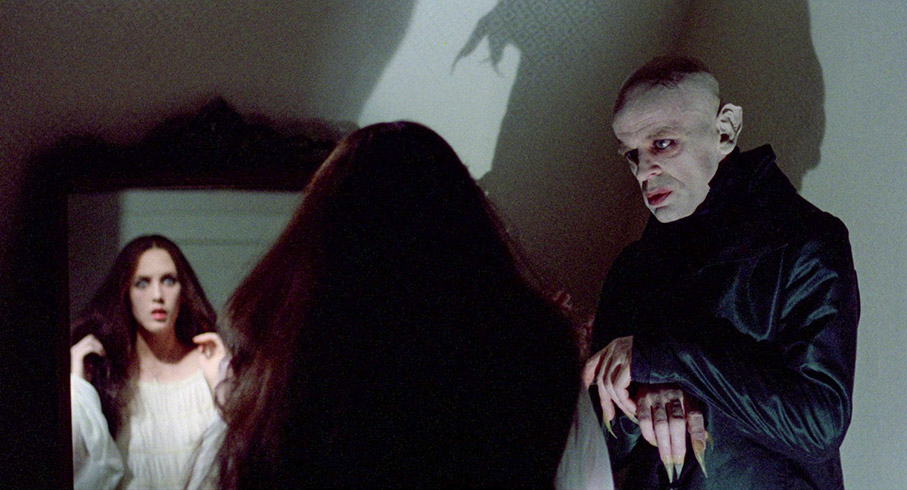
Commentary by Werner Herzog and Norman Hill
As with the commentary on the Aguirre disc, this was recorded late in the last century for an earlier DVD release. Specifically, it was recorded in 1998, as Norman Hill at one point refers to "last year" as the centenary of Dracula the novel. Herzog regards Murnau's film as the greatest German film and discusses his motives for taking on this version – not a remake, he says, but a revisiting. He says that his generation of German filmmakers was "orphaned", because their fathers' generation collaborated with the Nazis. So they had to look back to their grandfathers' generation: not just Murnau but Fritz Lang and G.W. Pabst as well. Nosferatu was Herzog's first "genre" film, but especially in America 20th Century Fox found the results not to align to their ideas of genre. Hill suggests that of the mini-flurry of vampire movies the same year (the John Badham take on Dracula with Frank Langella, the comedy Love at First Bite), Nosferatu was the least commercially successful but is the one which has endured the most. Herzog suggests that the reason that many of Kinski's two-hundred-plus film roles were small ones, likely involving just a day or two of filming, were because most people couldn't stand to work with him for longer than that. In fact, some of his crew asked him why he was working with "that pestilence" for a second time of eventually five. Isabelle Adjani was also not easy to work with but for a different reason: she was very insecure and needed a lot of attention and reassurance. Talking of other takes on Dracula and other vampires, Herzog has a lot of issues with Francis Coppola's 1992 Bram Stoker's Dracula. One reason he says that a vampire film has at some point to segue from the real into the irreal and Coppola's film did not do that – in fact it did the reverse at the start and never went back. There are also talks of the practicalities of the film, which was shot with one camera and a limited number of takes – about 100,000 feet of raw stock, he estimates. The 11,000 rats were bought from a Hungarian laboratory, dyed grey from the original white (a task in itself), and when they were transported to the Netherlands, a custom official opened the box and fainted.
Commentary by Werner Herzog and Laurens Straub
Recorded what I estimate was six years after the above-detailed commentary (Herzog states at one point that 25 years have passed since the film's completion), this second commentary track teams Herzog with his long-time friend and fellow filmmaker, Laurens Straub, with whom he has worked on several film projects. Inevitably, there is some crossover with the earlier commentary, particularly when discussing the background of specific scenes – including the opening shots of the Mexican mummies and the transportation and handling of so many rats – but the details provided often differ here. Herzog explains his thinking behind specific scenes and shots, reveals that he was not allowed to film in Transylvania and that the village locals were played by local Romany people, that he has a thing for maps and hates night shoots, and that he was bitten 30 times by the rats during the shooting of scenes involving these animals (he seem to have a thing about that number, also claiming in his on-stage interview on this that he was bitten at least 30 times by the monkeys during the filming of Aguirre, the Wrath of God.) He is full of praise for Klaus Kinski's performance, describing him as "the last expressionist actor" and stating at one point, "Kinski is so amazing. I can only thank him on my knees." He does confirm, however, that Kinski was his usual confrontational self on set, with scandals and screaming outbursts proving daily occurrences, but assures us that he was a different person when working with the film's Japanese makeup artist Reiko Kruk, whom he deeply respected and would patiently sit for during the four hour stint it took to apply his makeup each day. Herzog confirms that he read a lot of vampire literature when prepping for the film, reflects on the legitimisation of German culture after the war and the importance of critic and archivist Lotte Eisner to the process, identifies the locations and praises Florian Fricke's music, and is open about the elements that were lifted from Murnau's original, a film he describes as "unsurpassed in the history of German cinema." The commentary is conducted in German (the first commentary with Norman Hill is in English) with optional English subtitles. Unusually, I did spot a couple of minor typos ("a shipped passed the window" and "when the rats got to close") but otherwise they are fine.
Introduction by Mark Kermode (2:24)
Recorded in 2016, this is another of the BFI Player introductions by critic Mark Kermode that have been popping up on some BFI discs of late. Here, Kermode acknowledges the greatness of the original and suggests that Herzog's film in some ways improves upon it (despite my admiration for this version, we'll have to differ on that one), but is absolutely right when he notes how Klaus Kinski makes his interpretation of Max Shreck's wonderfully grotesque vampire his own.
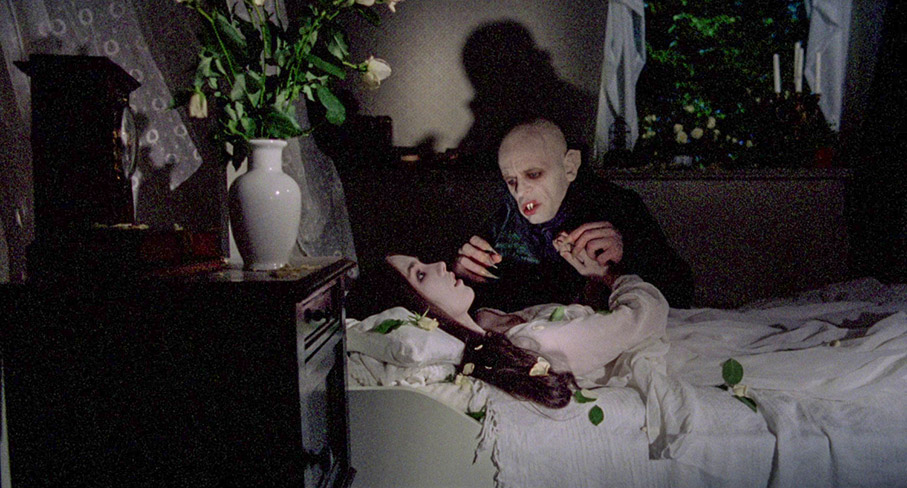
Contracting Vampirism: A Copyright History of Nosferatu (15:08)
A new Essay by filmmaker and photographer, Nic Wassell, that traces the history of Bram Stoker's seminal Dracula and the unauthorised 1922 film adaptation that was F.W. Murnau's Nosferatu, whose release promoted Stoker's widow to take legal action that saw almost every print of the film destroyed. He discusses Stoker's own ill-fated (and frankly deadly-sounding) stage adaptation of his novel, as well as Herzog's re-imagining of Murnau's original, and draws some interesting parallels between the text of the novel and the copyright battle that almost saw Murnau's film wiped from history.
Screen Talk: Werner Herzog (68:48)
This on-stage interview with Herzog was conducted by broadcaster Francine Stock at the BFI London Film Festival as part of its Screen Talk strand at Picturehouse Central on 14 October 2016. Herzog talks briefly about being unaware that cinema even existed until he was 11 years old, and recalls knowing for sure in his teens that he would make films, and make better ones than those that he was seeing. As the interview coincides with a festival screening of what was then his latest film, the documentary feature Lo and Behold: Reveries of the Connected World, there's quite a bit of discussion about this, including Herzog's still pertinent observation about Elon Musk's obsession with colonising Mars, stating that we should be using those resources to improve the situation on Earth instead. Other films discussed include Aguirre, the Wrath of God (1972), Grizzly Man (2005), Encounters at the End of the World (2007), and the documentary Little Dieter Needs to Fly (1997) and the subsequent feature film version of the Dieter Dengler story, Rescue Dawn (2006), all of which Herzog has interesting stories about, some of which I'd heard before while others were new to me. He has a low opinion of film schools, despite having then just started one himself, and really has a dislike for people who meditate – the mere mention of the word meditation sends him on an amusingly contemptuous rant. He takes a small number of questions from the audience, and says of his craft, "You have to know the heart of men when you are a director. And that's what I do in my profession, otherwise I shouldn't make films." As ever with Herzog, this proves a highly engaging and entertaining watch – for me, he's someone whose calm and thoughtful delivery, distinctive voice, and genuine interest in the subjects he covers makes him one of the most enjoyable interviewees in the business.
Making of Nosferatu the Vampyre (13:08)
A short featurette from the time made by 20th Century Fox for the film's US release. Behind-the-scenes footage from the shoot in the Netherlands is interspersed with Herzog talking to camera. He speaks in English (though at one point he's talking to Kinski in German). He says he doesn't want to film in open spaces he hasn't experienced with his body, and his films are born from pain rather than pleasure. He calls Nosferatu his eighteenth film (counting shorts and documentaries as well as features) and says that he hopes to make a film as good as one by Murnau or other directors such as Kurosawa and he can then retire. That was in 1979. More than forty-five years later, Herzog is eighty-three as I write this, and I wonder if he still thinks this?
Stills gallery (3:33)
A self-navigating gallery, beginning with a poster design and then stills, of the publicity and production variety, mostly in colour with some in black and white.
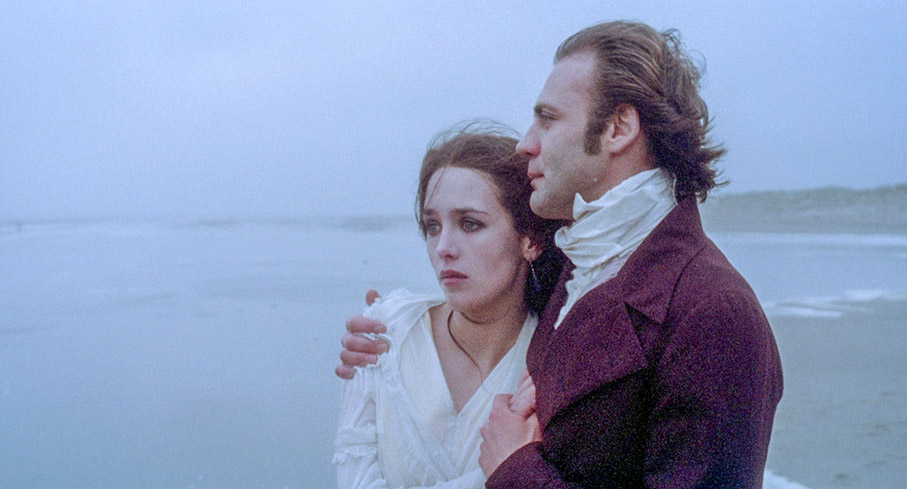
Theatrical trailer (2:03)
This is an odd trailer, not using any footage from the film in either version, but a series of stills interspersed with stylised images of the Count, with no voiceover, just music. It uses the English-language title and onscreen text is in that language.
Booklet
Leading the way here is a 2014 essay by Associate Professor of German at the University of Illinois at Urbana-Champaign, Laurie Johnson, who explores the links between Herzog's film and Murnau's original, and makes the case for the former as an expressionist work, including its use of colour. She also deconstructs individual scenes, and suggests that, "Nosferatu is replete with images of nature run amok, both in the world without and the world within," an intriguing statement that she goes on to justify.
Next is a review from the July 1979 issue of Monthly Film Bulletin by Tom Milne, an often perceptive critic whose views I nonetheless used to intermittently find myself at odds with (shall we talk Blade Runner?), and who here appears to be in two minds about a film whose admirable qualities he believes are sometimes undermined by Herzog's aping of elements from Murnau's original.
This is followed by a lengthy and detailed piece from the Autumn 1978 issue of Sight & Sound by producer, publicist and writer Beverly Walker, who worked on the film as a dialogue coach and ended up playing a small uncredited role as a nun. She provides a fascinating insider's view of the making of the film, painting a captivating picture of Herzog's winning way with actors and crew alike, and mixing first-hand observations with factual information about the production. She chronicles how one sensationalist newspaper headline saw the cooperation the production was receiving from the local authorities quickly dissolve, has some revelatory details about the cast and crew accommodation, and recounts a conflict with the farmer on whose property the rats were being stored that ended in violence.
Credits for the film and the special features are also included.
Somewhat out of step with what Werner Herzog had made up to that point, and with what was happening in the horror genre at the time, Nosferatu the Vampyre endures as a fine film, now enshrined in UHD with a strong transfer and some substantial and informative special features.
|